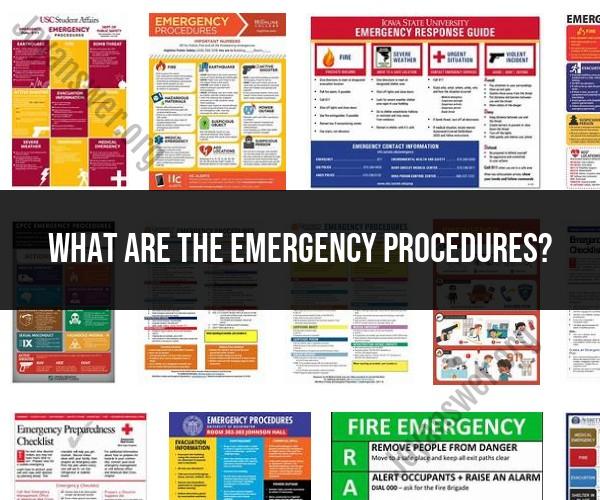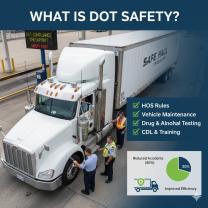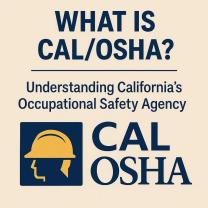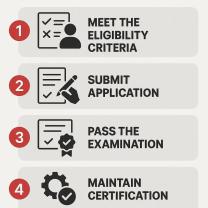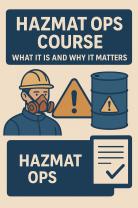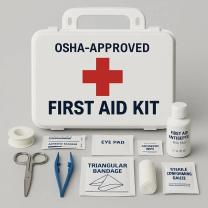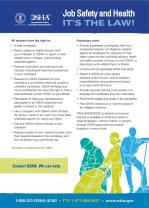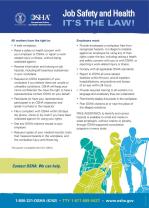What are the emergency procedures?
Emergency procedures can vary depending on the type of emergency or crisis situation. However, there are some general guidelines and protocols that can be followed to ensure safety and effective response in various emergency scenarios. Here are some common emergency procedures:
Evacuation: In cases of fire, natural disasters, or other immediate threats, evacuating the premises or the affected area is often the first step. Follow designated evacuation routes and assembly points.
Shelter in Place: In some situations, it may be safer to stay indoors and "shelter in place." This is often the case during severe weather events or when there is a threat of chemical or biological contamination. Seal windows and doors, turn off HVAC systems, and stay informed.
Medical Emergencies: If someone is injured or experiencing a medical emergency, call for medical assistance immediately (911 in the United States). Administer first aid if trained to do so and provide comfort and reassurance to the individual.
Fire Safety: In the event of a fire, activate fire alarms, alert others, and evacuate the building following established evacuation routes. Do not use elevators during a fire.
Earthquakes: During an earthquake, "Drop, Cover, and Hold On" is often recommended. Drop to the ground, take cover under a sturdy piece of furniture, and hold on until the shaking stops.
Active Shooter Situations: If you find yourself in an active shooter situation, remember to "Run, Hide, Fight." Try to escape the area if possible. If you can't escape, find a secure hiding place. As a last resort, be prepared to defend yourself and others.
Severe Weather: Pay attention to weather alerts and warnings. Seek shelter during severe storms, hurricanes, tornadoes, or other extreme weather events.
Chemical Spills or Hazmat Incidents: If there is a chemical spill or hazardous materials incident, move to a safe location upwind of the hazard, and follow instructions from emergency responders.
Power Outages: During a power outage, use flashlights or battery-powered lanterns for lighting. Unplug sensitive electronic equipment to protect them from power surges when the electricity is restored.
Communication: In all emergency situations, it's crucial to maintain communication with authorities and follow their instructions. Have a designated meeting point or a communication plan with family members or colleagues.
It's important to note that emergency procedures may vary by location, organization, or facility. Always be familiar with the specific procedures and protocols established in your area or workplace. Additionally, emergency preparedness and training can play a significant role in responding effectively to various emergencies, so consider seeking relevant training or certification if necessary.
Emergency Procedures: A Step-by-Step Guide to Preparedness
Before an emergency:
- Make a plan. Talk to your family and household members about what to do in different emergency situations, such as a fire, earthquake, or flood. Designate meeting places and create an emergency contact list.
- Be informed. Stay up-to-date on local weather conditions and emergency alerts. Know the evacuation routes for your area and have a plan for getting to safety.
- Prepare a kit. Assemble an emergency kit that includes food, water, first-aid supplies, and other essential items.
During an emergency:
- Stay calm and assess the situation. Follow the instructions of emergency personnel.
- Evacuate if necessary. Do not go back inside a building until emergency personnel give you the all-clear.
- Help others if you can. But do not put yourself in danger.
After an emergency:
- Stay informed. Follow the instructions of emergency personnel and local officials.
- Check on your loved ones. Make sure everyone is safe and accounted for.
- Help clean up and rebuild. Volunteer your time and skills to help your community recover from the emergency.
Navigating Emergencies: What to Expect in Emergency Situations
Emergency situations can be unpredictable and chaotic. It is important to be prepared and to know what to expect.
Here are some general things to expect in an emergency situation:
- Confusion and chaos. Emergency situations can be very confusing and chaotic. There may be a lot of noise and activity, and it may be difficult to get information.
- Stress and anxiety. It is normal to feel stressed and anxious in an emergency situation. This is a natural response to danger.
- Fear and panic. Some people may experience fear and panic in an emergency situation. This is also a normal response to danger.
If you find yourself in an emergency situation, it is important to stay calm and follow the instructions of emergency personnel.
Emergency Department Insights: A Glimpse into Critical Care Scenarios
Emergency departments are designed to treat patients with urgent and life-threatening conditions. Patients who arrive in an emergency department are triaged, or prioritized, based on the severity of their condition.
The most critical patients are seen first. These patients may be in need of immediate medical attention, such as resuscitation or surgery.
Less critical patients may have to wait longer to be seen. However, all patients in an emergency department are treated as quickly and safely as possible.
Here are some of the most common critical care scenarios that are seen in emergency departments:
- Cardiac arrest: This occurs when the heart stops beating. Cardiac arrest patients require immediate CPR and defibrillation.
- Stroke: This occurs when the blood supply to the brain is interrupted. Stroke patients require immediate medical attention to prevent further brain damage.
- Trauma: This refers to injuries caused by an accident or violence. Trauma patients may require surgery, blood transfusions, and other medical interventions.
- Sepsis: This is a life-threatening condition that occurs when the body's overactive response to an infection damages its own tissues and organs. Sepsis patients require immediate medical attention to prevent death.
Emergency departments are staffed by highly skilled and experienced medical professionals who are trained to handle critical care scenarios. If you or someone you know is experiencing a medical emergency, do not hesitate to call 911 or go to the nearest emergency department.
